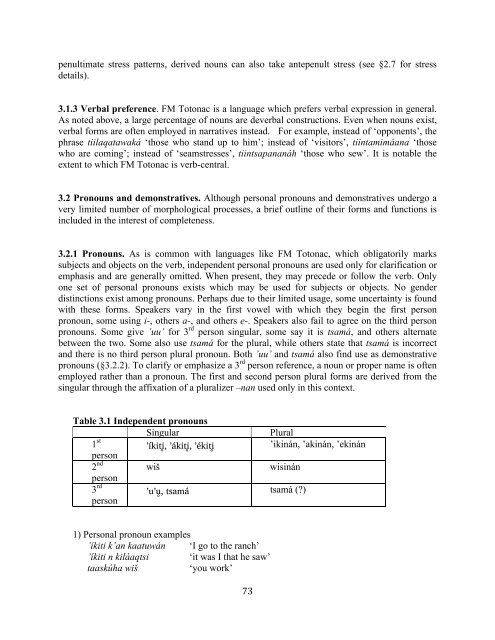The phonology and morphology of Filomeno Mata Totonac
The phonology and morphology of Filomeno Mata Totonac
The phonology and morphology of Filomeno Mata Totonac
You also want an ePaper? Increase the reach of your titles
YUMPU automatically turns print PDFs into web optimized ePapers that Google loves.
penultimate stress patterns, derived nouns can also take antepenult stress (see §2.7 for stress<br />
details).<br />
3.1.3 Verbal preference. FM <strong>Totonac</strong> is a language which prefers verbal expression in general.<br />
As noted above, a large percentage <strong>of</strong> nouns are deverbal constructions. Even when nouns exist,<br />
verbal forms are <strong>of</strong>ten employed in narratives instead. For example, instead <strong>of</strong> ‘opponents’, the<br />
phrase tiilaqatawaká ‘those who st<strong>and</strong> up to him’; instead <strong>of</strong> ‘visitors’, tiintamimáana ‘those<br />
who are coming’; instead <strong>of</strong> ‘seamstresses’, tiintsapananáh ‘those who sew’. It is notable the<br />
extent to which FM <strong>Totonac</strong> is verb-central.<br />
3.2 Pronouns <strong>and</strong> demonstratives. Although personal pronouns <strong>and</strong> demonstratives undergo a<br />
very limited number <strong>of</strong> morphological processes, a brief outline <strong>of</strong> their forms <strong>and</strong> functions is<br />
included in the interest <strong>of</strong> completeness.<br />
3.2.1 Pronouns. As is common with languages like FM <strong>Totonac</strong>, which obligatorily marks<br />
subjects <strong>and</strong> objects on the verb, independent personal pronouns are used only for clarification or<br />
emphasis <strong>and</strong> are generally omitted. When present, they may precede or follow the verb. Only<br />
one set <strong>of</strong> personal pronouns exists which may be used for subjects or objects. No gender<br />
distinctions exist among pronouns. Perhaps due to their limited usage, some uncertainty is found<br />
with these forms. Speakers vary in the first vowel with which they begin the first person<br />
pronoun, some using i-, others a-, <strong>and</strong> others e-. Speakers also fail to agree on the third person<br />
pronouns. Some give ’uu’ for 3 rd person singular, some say it is tsamá, <strong>and</strong> others alternate<br />
between the two. Some also use tsamá for the plural, while others state that tsamá is incorrect<br />
<strong>and</strong> there is no third person plural pronoun. Both ’uu’ <strong>and</strong> tsamá also find use as demonstrative<br />
pronouns (§3.2.2). To clarify or emphasize a 3 rd person reference, a noun or proper name is <strong>of</strong>ten<br />
employed rather than a pronoun. <strong>The</strong> first <strong>and</strong> second person plural forms are derived from the<br />
singular through the affixation <strong>of</strong> a pluralizer –nan used only in this context.<br />
Table 3.1 Independent pronouns<br />
Singular Plural<br />
1 st<br />
person<br />
’íkiti&, ’ákiti&, ’ékiti&<br />
’ikinán, ’akinán, ’ekinán<br />
2 nd<br />
person<br />
wi" wisinán<br />
3 rd<br />
person<br />
’u’u&, tsamá<br />
tsamá (?)<br />
1) Personal pronoun examples<br />
’íkiti k’an kaatuwán ‘I go to the ranch’<br />
’íkiti n kiláaqtsi ‘it was I that he saw’<br />
taaskúha wi# ‘you work’<br />
! +'!

















